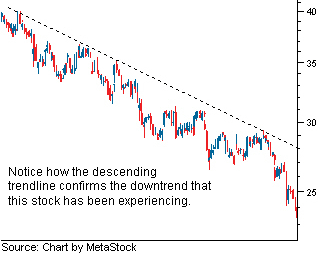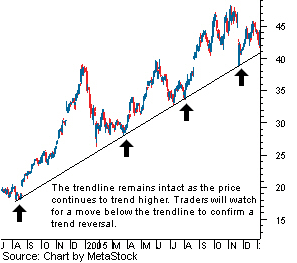Uptrends and downtrends are hot topics among technical analysts and traders because they ensure that the underlying market conditions are working in favor of a trader's position rather than against it. Trendlines are easily recognizable lines that traders draw on charts to connect a series of prices together. The resulting line is then used to give the trader a good idea of the direction in which an investment's value might move. In this article, you'll discover how to use this tool. It won't be long before you're drawing them on your own charts to increase your chances of making a successful trade! (For related reading, see Short-, Intermediate- And Long-Term Trends.)
| |
Trendline Basics
Understanding the direction of an underlying trend is one of the most basic ways to increase the probability of making a successful trade because it ensures that the general market forces are working in your favor.
Downward sloping trendlines suggest that there is an excess amount of supply for the security - a sign that market participants have a higher willingness to sell an asset than to buy it. As you can see in Figure 1, when a downward sloping trendline (black dotted line) is present, you should refrain from holding a long position - a gain on a move higher is unlikely when the overall longer-term trend is heading downward. Conversely, an uptrend is a signal that the demand for the asset is greater than the supply and is used to suggest that the price is likely to continue heading upward.
Understanding the direction of an underlying trend is one of the most basic ways to increase the probability of making a successful trade because it ensures that the general market forces are working in your favor.
Downward sloping trendlines suggest that there is an excess amount of supply for the security - a sign that market participants have a higher willingness to sell an asset than to buy it. As you can see in Figure 1, when a downward sloping trendline (black dotted line) is present, you should refrain from holding a long position - a gain on a move higher is unlikely when the overall longer-term trend is heading downward. Conversely, an uptrend is a signal that the demand for the asset is greater than the supply and is used to suggest that the price is likely to continue heading upward.
 |
| Figure 1 |
Trendlines can vary drastically depending on the time frame used and the slope of the line. For example, some securities can show aspects of uptrend/downtrends for months, days or even a few minutes while others can become range-bound and trade within a sideways trend.
Support and Resistance
Trendlines are a relatively simple tool that can be used to gauge the overall direction of a given asset but, more importantly, they can also be used by traders to help predict areas of support and resistance. This means that trendlines are used to identify the levels on a chart beyond which the price of an asset will have a difficult time moving. This information can be very useful to traders looking for strategic entry levels or can even be used to effectively manage risk by identifying areas to place stop loss orders. (For more insight, see Support & Resistance Basics, and Support And Resistance Zones - Part 1 and Part 2.)
Technical traders pay particularly close attention to an asset when the price approaches a trendline because these areas often play a major role in determining the short-term direction of the asset's price. As the price nears a major support/resistance level there are two different scenarios that can occur: 1) The price will bounce off the trendline and continue in the direction of the prior trend, or 2) it will move through the trendline, which can then be used as a sign that the current trend is reversing or weakening.
Drawing Your Own Trendlines
As mentioned earlier, trendlines are simply lines that connect a series of prices to give the trader a better idea of where the price of a particular investment is headed. The problem with this statement is that it doesn't mention which prices are used to create the trendline. As you may know, the open, close, low and high prices are easily obtained for most stocks, but which of these prices should be used when creating a trendline?
In fact, there is no one distinct answer to this question. Technical signals generated by the various technical patterns/indicators are very subjective and trendlines are no exception. It is entirely the trader's decision when it comes to choosing what points are used to create the line and no two traders will always agree to use the same points. Some traders will only connect closing prices while others may choose to use a mix of close, open and high prices. Regardless of the prices being connected, it is important to note that the more prices that touch the trendline the stronger and more influential the line is believed to be.
In general, upward sloping trendlines are used to connect prices that act as support while the given asset is trending upward. This means that upward sloping trendlines are mainly drawn below the price and connect either a series of closes or period lows. Conversely, a downward sloping trendline is generally used to connect a series of closing prices or period highs that act as resistance while the given asset is trending downward; this is similar to what is shown in the chart above. We should note that it is possible to use two trendlines on the same chart. However, this method, known as a channel, goes beyond the scope of this article. (To learn more about this technique see, Channeling: Charting A Path To Success.)
|
To illustrate the concept of drawing an ascending trendline, we have chosen to look at the trading action of AutoDesk Inc. (ADSK) between August 2004 and December 2005. As you can see in Figure 2, the trendline is drawn so that it connects the lows illustrated by the black arrows. Once a trendline is established, traders would expect to see the price of the asset to continue to climb until the price closes below the newly formed support.
 |
| Figure 2 |
As time goes on, we can see in Figure 3 that the price tested the support of the trendline again in August 2005. This is important because the more times the price touches the trendline, the more influential the line is said to be. The price action illustrated by the arrow on the far right, below, would be used by traders as confirmation that the trendline is valid. In this case, traders would look to enter a long position as close to the trendline as possible.
 |
| Figure 3 |
Once a technical trader has entered a position near the trendline, he or she would keep the position open until the price moved below the support of the trendline. Most traders will constantly adjust their stop-loss orders by moving them higher as the trendline continues to slope upward. This method ensures that a trader can lock in as much of the gain as possible without being taken out of the position too early. Keeping a stop-loss order below an influential trendline is a strategic way to ensure that the asset has adequate room to fluctuate without getting whipsawed. As you can see in Figure 4, in this case, using the ascending trendline as a guide of an expected move higher would result in a very profitable trade.
 |
| Figure 4 |
Conclusion
Trendlines are used commonly by traders who seek to ensure that the underlying trend of an asset is working in favor of their position. Trendlines can be used effectively by traders to gauge potential areas of support/resistance, which can help to determine the likelihood that the trend will continue. This strategic advantage is available to any trader willing to take the time to learn how to draw a basic trendline and incorporate it into his or her trading strategy. Although many traders will argue over what prices to use when creating the trendline, remember that all will agree that the strength of the trendline increases as more prices test the support/resistance.
To learn more about chart patterns, check out the Technical Analysis tutorial.
By Casey Murphy,
Access Investopedia's Forex Advisor FREE Report - The 5 Things That Move The Currency Market
No comments:
Post a Comment